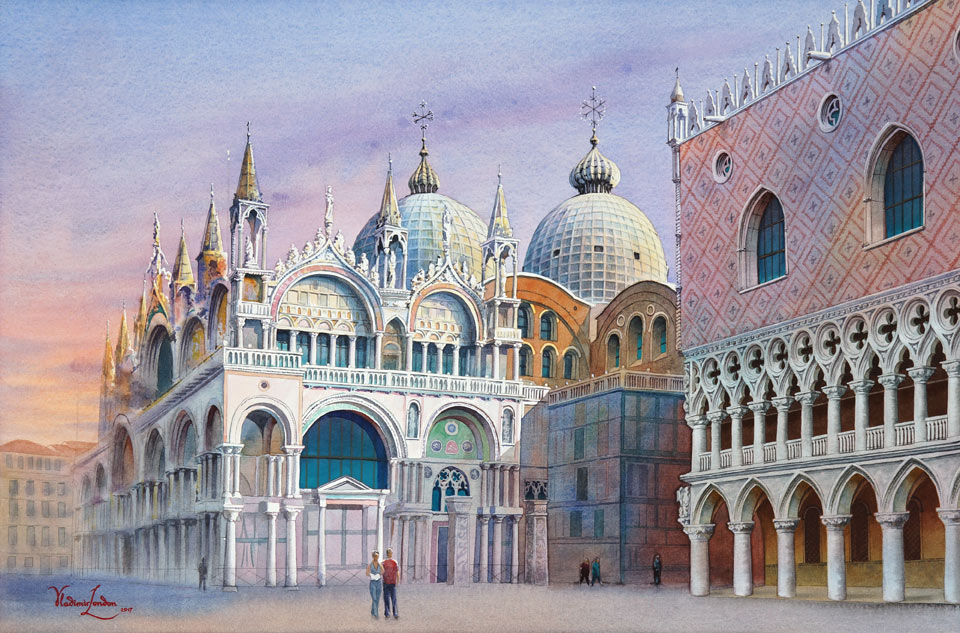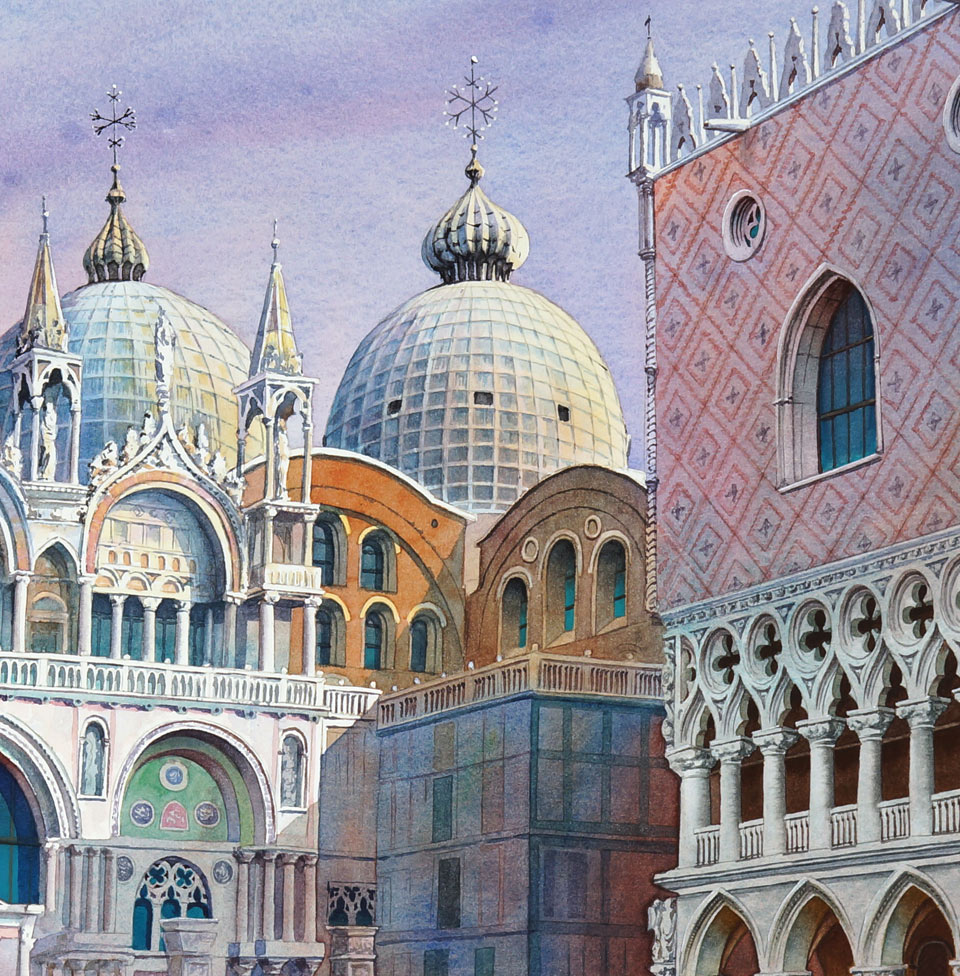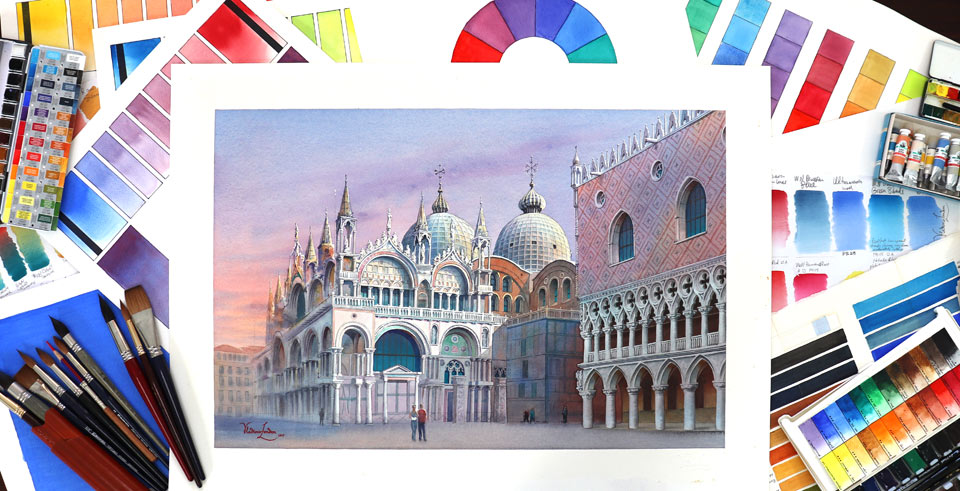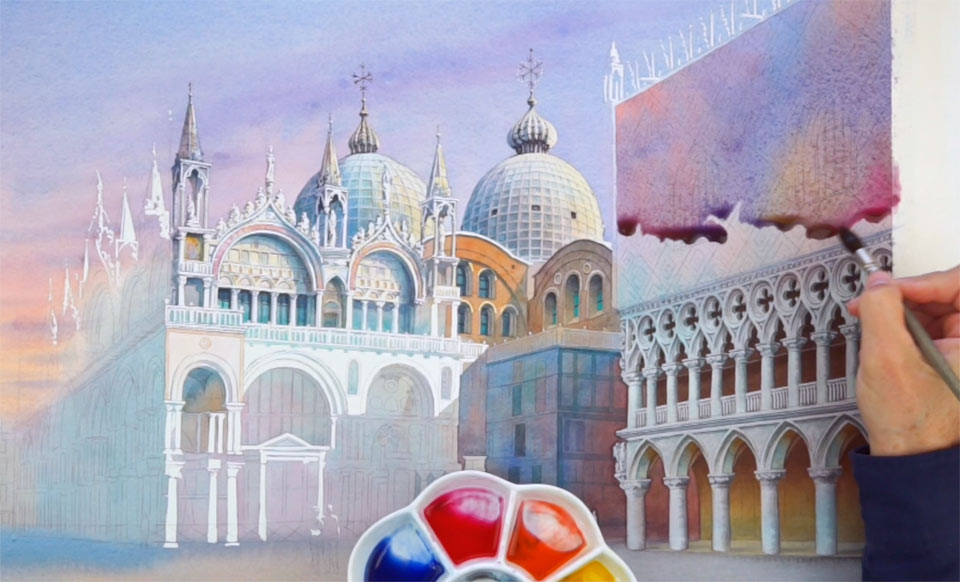A self-study, self-paced course where you can learn how to paint in watercolor by watching video lessons and doing assignments
$297 USD
ENROLL NOWA self-study, self-paced course where you can learn how to paint in watercolor by watching video lessons and doing assignments
$297 USD
ENROLL NOWOne-to-one, unlimited and custom-tailored to your skills and needs Personal Tutoring by the Watercolor Academy teachers
$997 USD
ENROLL NOWVideo lesson by Vladimir London
In this video lesson, you will discover how to paint a historical cityscape, a highly-detailed artwork that features iconic Venetian architecture.
Here is the artwork I will create by the end of this video lesson.

This piece begins with a fast, preliminary sketch in watercolor of the location, on the Paizza San Marco in Venice, Italy. I will do this preliminary sketch in the pen-and-wash watercolor painting technique. For the outlines, I used a thin permanent marker and now I'm applying paints on top, in quite a casual manner because the drawing is already in place and the black markings will play an integral part of this piece. In a way, I don't have to stay too closely within the marker lines and the purpose of the watercolor wash is simply to add an impression of the colors I can use as a reference for the main piece. Because of its disposable purpose, I have no intention of completing this artwork. It is just a quick exercise to get the feeling of place, colors, and design. Here is the finished preliminary sketch.
I'm back in the studio where I have the luxury of painting a big scale piece. Now I'm tracing the design on the watercolor paper. To give this artwork a clean, framing edge, I will apply the masking fluid along the four sides of the piece. To do this, I will use a very cheap synthetic flat brush, which I first moisten with liquid soap so the masking fluid doesn't stick to the hairs, and then apply the colorless masking fluid freehand without any ruler. While the masking fluid is drying, I can decide on the paint for the imprimatur, which will be the very first wash. I will use a very light tint of the Winsor Blue (Green Shade) paint, which I apply with a soft, natural-hair mop brush from Escoda in multiple diagonal brush strokes, using the plain-saw-wash watercolor painting method. The main advantage of this method is a very smooth application of paint without any visible borders between brushstrokes, even though I'm using a very small brush for this job. While doing this wash, I have to keep an eye on the bead that collects at the bottom edge at all times, and also not miss any gaps between brushstrokes to avoid white, unpainted spots. This first imprimatura wash makes the paper off-white and gives it a very light blue color. At the end of the wash, I absorb the bead with a damp squeezed-out brush and let this layer completely dry before applying masking fluid to preserve some light areas of the design. I do it with a thin, round, synthetic brush.

For the next wash, I will use two natural-hair mop brushes from Escoda, #10 and #14. For the variegated wash, I premixed eight pigments. In no particular order, they are: blue, red, orange, yellow, a darker shade of orange, teal, dark blue, and purplish-brown. The choice of exact pigments is completely discretionary. All I wanted is a selection of both cool and warm pigments from all sides of the color wheel. The variegated wash will be almost random without paying too much attention to the borders of the design. I'll just apply different colors in their approximate locations - for example, blue for the sky; purple and red for the part of the sky that is closer to the horizon; red, yellow, and blue for the buildings - or at least this is the idea I have in mind. Because it is such a detailed artwork, I don't want to segregate it by meticulously filling in very specific colors for each area. Instead, I want those colors to freely flow between each other and intermix on the paper surface. This will create a united colorful underpainting which I will let thoroughly dry after it's done and use it to paint all the details on top. The scale of this watercolor is quite big and a variegated wash is quite a fast way to do the underpainting.

When the paper is totally dry, I remove the masking and can now paint the smaller details of St. Mark's Basilica with a smaller, natural-hair brush from Escoda. I would like to make a highly detailed, realistic piece, so it will take a lot of time and effort to paint hundreds of small details of this basilica. When making such an illustration, there is one good tip to keep in mind: If you apply both cold and warm colors on the same building, it will look more interesting. Warm colors might suggest light areas lit by the sun; and the parts of the building painted with cool colors appear in shadow which reflects the blue color of the sky. Of course, when it comes to intrinsic color, for example, the red brick-work, you must consider that color as well. The wall I'm painting now is in shadow. Its tone is dark and the color is cool. However, even in dark and cool areas, it is good to add warmer colors into the mix, as I'm doing right now, making this variegated wash. The color of this wall consists of several pigments from cold to warm. Nevertheless, it looks like one unit.

Painting so many architectural details requires a lot of patience. I'm slowly adding dark tones of the stone windows and arches to build up tonal values on this design. Next to the Basilica of St. Mark stands the Doge Palace. It was built about ten centuries ago and, from this palace, 120 doges directed the politics of the city of Venice. During the history of this building, there were several alterations of its design and construction. Several huge fires affected this palace in various years. Despite many renovations, architects managed to keep the original gothic style which remains to this day.
I'm painting the passage behind the columns and arches in warm colors to suggest the reflected light that is bouncing from the ground. I premixed four colors - blue, red, orange, and yellow - to paint the palace wall with a variegated wash. This wall is famous for changing its color during the day, depending on the changing light. Right now, this wall is in shadow so I will do it quite dark, but nevertheless colorful. I'm adding one pigment next to another, overlapping brush strokes so the paint flows freely and intermixes the different colors on the paper. With this variegated wash, it is possible to achieve very picturesque results. Even though I'm using very bright, primary colors (red, yellow, and blue) and a couple of secondaries (orange and purple), the contrast of hues looks quite balanced. Also, there is very little light and dark contrast on this wall. When this wash dries, the tone of the wall will look lighter and the colors duller, so I'm not worried too much about going crazy with colors at this step.
There are two big windows we can see on this wall. Their arches are dark because they are situated away from the sky, and its color is warm because it catches the reflected light that is bouncing from the ground. I will add a bright and opaque turquoise pigment to attract attention to these windows. This is an illustration, not a hyper-realistic artwork. So, I'm using my creative license to add colors you would not necessarily see in real life at this time of the day. What I achieved with this turquoise pigment is a higher warm and cold contrast for this wall. Without such contrast, the wall was looking quite cool, having predominantly blue and purple colors. Now, it visually appears warmer, having a more pinkish color, as it has in real life. Also, I will add the decoration design of this wall in pink. This will complete the Doge Palace.
Now we can come back to the Basilica of St. Mark's. This is the focal point of the piece, so I need to spend a bit of time painting its details. For this part of the basilica, on the left-hand side, I will use a different painting method - not wet-on-dry but wet-into-wet. To do this, I will first apply clean water with a flat brush over this part of the building, and then paint the architectural details impressionistically on the wet surface of the paper so the brush strokes diffuse and have soft borders. The contrast between sharp and soft borders of brush strokes makes this artwork more interesting, and also, quite importantly, tells a viewer where the focal point of this painting is and what the secondary areas are.
Any cityscape artwork always looks better when there are some human figures around. I will add a couple on the square in the middle of the piece and a few figures in the background next to the building, which gives a nice scale to this basilica.
A self-study, self-paced course where you can learn how to paint in watercolor by watching video lessons and doing assignments
One-time payment - Lifetime membership
$297 USD
One-to-one, unlimited and custom-tailored to your skills and needs Personal Tutoring by the Watercolor Academy teachers
One-time payment - Lifetime membership
$997 USD